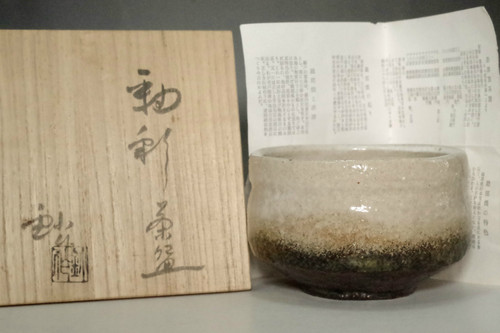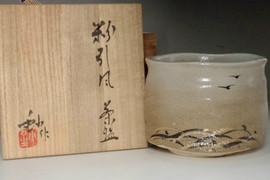Kato Sho (1927-2001) Seto ware tea bowl #3504
- SKU:
- 3504
- Shipping:
- Free Shipping
- width: approx. 12.3cm (4 27/32in)
- tall: approx. 8.3cm (3 17/64in)
- weight: 379g (gross 624g)
Seto ware
Although legend has it that ceramics in the Seto ware began when its forefather, Kato Shiroemon Kagemasa, built a kiln there in 1242 after having studied the methods from the Song dynasty in China, the origins of pottery-making in the area are much more ancient, dating back to the Tumulus period.
During the Kamakura period the Seto ware was the only one in Japan which produced glazed pottery. The flourishing of trade between Japan and the Song from the Heian to the Kamakura period led to a large volume of ceramics being brought in from the continent; the extant domestic ash glaze could no longer compete, which led to various changes in the Seto ware as well.
By the Muromacho period the tea ceremony had become popular, and once the Seto potters made tea things preferentially. The role of Seto region became a producer of practical tableware.
During the Warring States period many potters fled Seto for Mino in order to escape the war, as the term "Seto-yama-risan (Flight from Seto mountain)" suggests, where they received protection under the policies of Oda Nobunaga. Bowls and decorative plates with the distinctive style of Seto ware, Oribe, Shino and Ki-seto have been discovered in the remains of Mino's kilns from this period.
Upon entering the Edo period, the potters who had left Seto as part of the "Seto-yama-risan" returned to Seto region once again. The Owari branch of the Tokugawa family summoned the potters back to Seto as part of the so-called "Kamadoya-yobimodoshi (Summons to the kilns)", and the Seto area flourished once more.
However, the Seto area entered a difficult period due to their delay, as Kyushu's Arita ware expanded their sales routes from Imari port to Europe and beyond thanks to the temporary halt in exports from China, the biggest producer of ceramics.
In the late Edo period (1807), Kato Tamikichi, who had studied ceramics in Kyushu's Arita area and elsewhere, returned to Seto and regularized ceramic production there, leading to a dramatic change in Seto's pottery scene.
From that point onward, Seto's ceramics adapted well to the styles of the period and expanded production, even frequently exporting overseas during the Meiji period.
Japan the term "Seto-mono (Seto item)" is synonymous with ceramics at the present time.






















